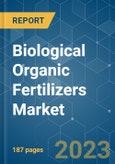Key Highlights
- The increased practice of organic farming is one of the significant factors behind the growth of the biological organic fertilizer market. The emphasis on sustainable agriculture and government support to the manufacturers are the other factors that augment the development of the market.
- Moreover, recent studies have shown the effect of bio-organic fertilizers on grains. Bio-organic fertilizer that exhibited various qualities, such as nutrient acquisition and plant growth promotion of rice, is an organic-based biofertilizer that contains RP (5%), biochar (15%), and the living cells of Plant Growth Promoting Bacteria (PGPB), mostly Bacillus, Proteus, and Paenibacillus spp., which were isolated from the floodplain, terrace, and saline soils. The results of 16 field experiments and 18 farmers’ demonstration trials undertaken by Bangladesh Rice proved that added PGPB supplemented the 30% synthetic N requirement of rice production through biological nitrogen fixation and fully complemented available P from rock phosphate by solubilization during the plant growth period. The combined effect of living ingredients and organic matter of the bio-organic fertilizer saved 30% urea-N, eliminated 100% Triple Super Phosphate fertilizer use in rice production, and simultaneously improved nutrient uptake, N, P use efficiencies, rice yield, and soil health, eventually enhancing the adoption of biological organic fertilizers.
Biological Organic Fertilizer Market Trends
Increasing Organic Farming
The rising popularity of organic products and consumption has forced the expansion of organic farming across the globe. Subsequently, the market for biological organic fertilizers has grown dramatically in response to the recent surge in interest in regenerative agriculture, organic farming, and soil health. Natural organic fertilizers contain specific levels of microorganisms (such as nitrogen-fixing bacteria); organic fertilizers similarly contain microorganisms and typically come from animals and plants, such as livestock manure and crop residues, which are highly suitable for Organic Farming.According to the Research Institute of Organic Agriculture, the area under organic farming increased by 4.1% in 2020. In addition, the regional statistics of both developed and developing countries have depicted the growth of organic agriculture in the country. For instance, according to the statistics by the government of India, the area under the organic farming certification process in India has almost doubled in 2021-2022, indicating the increasing initiatives and adoption of organic farming, with the full production accounting for 20,540.63 metric tons. Thus, owing to the rising organic area under cultivation and the increasing demand for good-quality crops, cultivators are anticipated to use biological organic fertilizers instead of excessive synthetic fertilizers, driving the market.
Asia Pacific is the fastest growing market
The organic fertilizer market in Asia-Pacific is the fastest-growing among all the other regions. The consumption of organic fertilizers in Asia-Pacific is anticipated to increase with rising awareness among farmers about the benefits of bio-based and organic residue-based fertilizers. The regional demand is concentrated among major agriculture-based countries like China, India, Thailand, Indonesia, and Vietnam while China and India are leading the market developments.In addition, not only do different countries in the region have their own regulations for fertilizers in general, but they also often have specific requirements and rules for biological and organic fertilizers. For instance, the Regulation of the MOA No. 1/2019 concerning the Registration of Organic Fertilizers, Biological Fertilizers, and Soil Improvement in Indonesia aims to ensure the quality of fertilizer products circulating in the market by requiring them to pass a quality test by an MOA-approved institution.
Further, the growing organic farming in different countries under the region and the increasing demand for organic products drive the market in the region. Moreover, there have been major policy developments related to the organic sector in some Asian countries. In Japan, there was a major development in the Basic Plan for Agriculture and Management, aiming to triple the number of organic farmers and organic land by 2030, in turn boosting the growth of the market.
Biological Organic Fertilizer Market Competitor Analysis
The Biological organic fertilizer market is fragmented due to prominent international and regional players. Collaborations with government organizations and expansion in the market, along with product innovation, are some of the strategies adopted by the companies. Rizobacter Argentina S.A, Lallemand, and National Fertilizers Limited are some of the leading market players in the biological organic fertilizer market. The unregulated scenario in the market has sustained the small companies, making the market fragmented, which could be converted to a consolidated one with the proper regulations shortly.Additional benefits of purchasing the report:
- The market estimate (ME) sheet in Excel format
- 3 months of analyst support
This product will be delivered within 2 business days.
Table of Contents
Companies Mentioned (Partial List)
A selection of companies mentioned in this report includes, but is not limited to:
- Rizobacter Argentina S.A.
- Lallemand Inc.
- National Fertilizers Limited
- Madras Fertilizers Limited
- T Stanes & Company Limited
- Gujarat State Fertilizers & Chemicals Ltd
- String Bio
- Rashtriya Chemicals & Fertilizers Ltd
- Agrinos
- Biomax Naturals
- Symborg (Corteva Agriscience)
- Agri Life
- Premier Tech
- Biofosfatos do Brasil
- Kiwa Bio-Tech Products Group Corporation
- Protan AG
- Mapleton Agri Biotech Pty Limited
- Bio Nature Technology PTE Ltd.
- Kribhco
- Bio Ark Pte Ltd
- Novozymes
- Savio BIO Organic AND Fertilizers Private Limited
- ACI Biolife
Methodology

LOADING...










